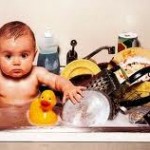Archive for November, 2012
Can Your Toothbrush Make You Sick?
Posted by: | CommentsCPRescue – Health and Wellness
There are possibly 700 species of bacteria that can live on your toothbrush. On average your mouth harbors anywhere between 30 to 70 different kinds of bacteria, even with good hygiene. The plaque you remove from your teeth, as you brush, is loaded with bacteria, which in the end ends up on your toothbrush.
At any given time you toothbrush can be a haven for 100 million bacteria. Though not all of these bacteria are harmful (even some can actually be helpful) there are still many of the nasty ones still present. Most likely your toothbrush will not make you ill. But can it? The answer is yes, if it’s not properly used and stored.
Just like you wouldn’t store your dining plates and glasses next to your toilet, you shouldn’t do the same with your toothbrush. Every time you flush, an invisible plume of vapor is released from your toilet and can hang in the air for several minutes. These contaminated water vapors easily travel and can end up on surfaces that are close by, such as your toothbrush.
Bacteria like moist places, after using and rinsing your toothbrush, store in an up-right position to let it dry. Do not lay it down where moisture can become trapped and begin to multiply. Also do not store your toothbrush next to other toothbrushes. Children or spouses that are sick, can easily spread disease if their toothbrush comes into contact with yours.
The best way to reduce and limit bacteria, is to replace your toothbrush on a regular basis. Replacing your toothbrush every three to four months is the recommendation from the American Dental Association. Good oral hygiene not only helps in the care and appearance of your teeth, it can also have an effect on your heart, but that is for another article.
First Aid for Shock
Posted by: | CommentsFirst Aid for Shock – by CPRescue
Shock left untreated can lead to permanent organ damage or death. Shock is a lack of oxygen getting to our vital organs and body tissues, which means there is a lack of oxygen in our blood.
Shock is usually from the results of a trauma, heatstroke, spinal injury, blood loss, an allergic reaction, severe infection, poisoning or severe burns. A person in shock can be conscious or unconscious.
Signs of a person in shock are:
- A cool and clammy feel of the skin.
- Loss of color or pale/grayness of the face.
- Blueness of the lips.
- A weak and rapid pulse.
- Possible nausea.
- A delayed refill effect of the capillaries under your nail bed.
To treat shock, immediately call 911. Have the person lay down, this makes it easier on the heart to move blood around the body. Keep the victim warm by covering them with a blanket or coat. If in a hot environment, it would be best not to over heat, try and maintain a normal body temperature, by possibly shading the victim. If no signs of spinal of leg injuries exist, lift the legs of the victim about 8 to 10 inches. With no vital organ in your legs we will use gravity to force more of the oxygen depleted blood, into the core of the body, where we do have vital organs. Continue to monitor the victims condition especially that they continue breathing until help arrives.
*Caution: DO NOT have a person lay down flat if they are experiencing signs or symptoms of a heart attack. It would be better to get them into a reclining position or a position the victim finds comfortable.
Surprising Dirty Places in Your Home
Posted by: | Comments Kitchen Sink – Would you believe your toilet maybe cleaner than your kitchen sink? Most of us will use a disinfectant cleaner to clean our toilets, whereas, we usually only rinse our sinks with plain water. Left-over food on plates can breed e-coli or salmonella. These germs can easily transfer onto your hands, which then can get into your mouth, eyes or nose, as well as other foods that you may prepare for consumption.
Kitchen Sink – Would you believe your toilet maybe cleaner than your kitchen sink? Most of us will use a disinfectant cleaner to clean our toilets, whereas, we usually only rinse our sinks with plain water. Left-over food on plates can breed e-coli or salmonella. These germs can easily transfer onto your hands, which then can get into your mouth, eyes or nose, as well as other foods that you may prepare for consumption.
Salt & Pepper Shakers – A University of Virginia study showed that almost all the Salt and Pepper shakers tested showed signs of the cold viruses.
Toothbrush – Most of you just rinse and put away our toothbrush, creating an inviting moist environment for bacteria growth. Also when flushing your toilets, a fine mist is released into the air which can be suspended for up to 2 hours. These fine droplets can fall upon exposed surfaces such as toothbrushes.
TV Remote – Any viruses and bacteria’s you pick up on your hands throughout the day are then deposited unto other surfaces, such as the one used by all family members, the TV remote control. Of all surfaces in your home this one is that contains the most recorded bacteria.
Computer Keyboard – If you eat at your computer, sneeze on your keyboard, or sit down to surf the Internet without first washing your hands, your computer keyboard could be a health hazard. In a recent study by a British consumer group, researchers swabbed keyboards for germs and found a host of potentially harmful bacteria, including E. coli and staph. Four of 33 sampled keyboards had enough germs to be considered health hazards. One had levels of germs five times higher than those found on most toilet seats.
To help control infections and the spread of disease, you may consider regularly cleaning these common household surfaces with a disinfectant or a solution of bleach and water.
Safety Tips for the Holidays
Posted by: | CommentsThe holidays are a time for families to celebrate and come together. It is also the time when hospitals report increases in the number of accidents and injuries. Now is the time to spend additional attention to your health and safety. Here are seven tips to help keep you safe and healthy during the holiday season.
- Handling and Preparation of Food – Food poisoning can put a damper on the holidays. Make sure to wash your hands before handling any food items. Clean and/or disinfect all food preparation surfaces. Avoid cross-contamination especially with meats or fowl. Cook all foods to their proper temperatures and refrigerate left-over as soon as possible.
- Hand Washing – The best way to keep from getting sick and spreading germs is to wash your hands often. Plain soap and water is all you need. The use of a and sanitizer will work when soap and water are not readily available. Avoid coughing or sneezing into your hands. The CDC now recommends that you cover your mouth or nose with your sleeve or into a disposable Kleenex, which is immediately thrown-away.
- Travel Safety – You have heard it a million times, don’t drink and drive. There is a reason why the Police and Highway Patrol increase their staffing during the holidays. In climate weather and holiday traffic, increase the opportunities for accidents. Allow extra driving time. You don’t want to resort to speeding or engage in reckless driving to make up time for leaving late or for unanticipated traffic delays. And always make sure everyone wears a seat-belt.
- Burns – Keep children out of the kitchen while preparing meals. Hot grease needs to be kept in a safe location. Pot handles should be point in and not left exposed away from the stove. This is an opportunity for kids to pull hot liquids down on them or adults accidentally bumping into the handles and spilling hot items on themselves or others. Cool all burns immediately with cool running water (no butter, lard, mayonnaise, egg, toothpaste or other home remedy). Small burns can be treated with an over-the-counter burn gel. Burns to the genitals, face or larger than 9% body area (about the size of your hand with fingers expanded) should be seen by a physician.
- Fires – Most residential fires happen in the winter months. Keep tree stands filled with water. Heated rooms can dry live trees out rapidly. Never leave candles, fireplaces, stoves or space heaters unattended. Check smoke detectors and replace batteries if it has been longer than 6 months. Have an emergency plan that is practiced with all family members. Children tend to hide when scared which makes it difficult to find them in smokey rooms. Teach them how to exit each room (have two solutions, such as the door or out a window) and have a rendezvous location outside of the home.
- Prevent Injuries – Use ladders and stools correctly instead of furniture when decorating. Hide or tape down with duct-tape all loose wires. Wear appropriate shoes when going outside. Rain, ice and snow can change the condition of walking surfaces. Use care and proper lifting techniques when lifting trees or large presents. Twisting or turning when lifting can cause falls and damage to your back. Nobody wants to spend their holidays in a hospital bed.
- Watch the Kids – This is an exciting time for the little ones. Their extra enthusiasm can put them into dangerous situation. Encourage their fun but in a safe manner. Give them toys appropriate for their age. Balloons, strings and ribbons are all potential suffocation or choking items for children under the age of 8. Have them dress properly before going outside. Always have them wear safety items such as helmets and knee or elbow pads when biking or using skates or skateboards.
Seizures
Posted by: | CommentsSeizures happen when there is an interruption to the electrical activity of the brain. Though there are several types of seizures, the most typical or the one we are most familiar with is, the grand mal seizure. This involves uncontrolled muscle contractions or convulsions throughout the body. Some physical signs of a grand mal seizure are, stiffening or spasm of the extremities. Loss of consciousness, bowel control and possible vomiting.
Your first step is to call 911 or alert EMS. Then protect the victim from any injuries by moving any furniture that the victim is hitting or coming in contact. Next place your hands behind the victims head to prevent them from suffering any kind of head trauma. Never try to restrain the victim during the seizure. Always allow them full freedom of motion. And lastly, do not place anything into the mouth of a seizing victim, the possible loss of fingers or damage to the victims teeth or mouth can occur.
Things that can cause a person to have a seizure are:
- Epilepsy
- Trauma to the head.
- Intoxication
- Drug overdose
- Infections
- High fever
- Stroke
Seizures can last from a few seconds to several minutes. After the seizure has ceased, the victim may still be very lethargic or unconscious. First evaluate if the patient has an open airway. If so, are they breathing, then check for any serious bleeding and finally look for signs of shock. If everything is working and the patient is not injured, move the patient onto their side by using the “recovery position” roll.
Swine Flu and Pregnancy
Posted by: | CommentsSwine flu (H1N1 virus) has killed 28 pregnant women in the U.S. raising the level of concern among obstetricians and CDC investigators. The CDC has reported an early start of the flu season and California is one of 27 states reporting widespread flu activity. Doctors throughout the country are bracing for an exceptional flu season and recommend people start taking precautions.
Fortunately, there’s a lot pregnant women can do. Even though pregnant women are advised to avoid many medications, the flu drug Tamiflu is safe for pregnant women — and should be given to them at the first sign of flu symptoms. Antiviral medicine can be a very important treatment for pregnant women who have respiratory symptoms or influenza-like illness. The H1N1 swine flu vaccine and the seasonal flu vaccine — the kinds that are given as a shot, not the kind given as a nasal spray — are safe for use during pregnancy. Talk with your doctor.
– Information provided by the CDC








